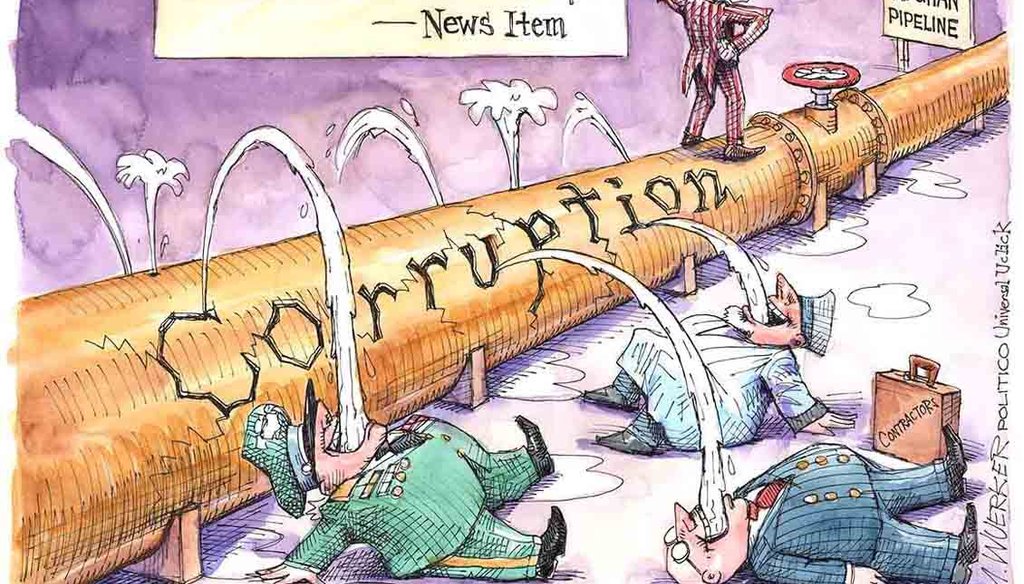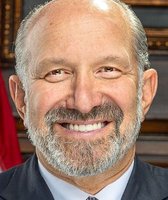Stand up for the facts!
Our only agenda is to publish the truth so you can be an informed participant in democracy.
We need your help.
I would like to contribute

This Matt Wuerker cartoon was published on Politico on Aug. 4, 2015.
As fact-checkers of pundits and media, we try to stay on top of where people are getting their information, constantly mining the usual places — TV and radio shows, columns, and Sunday shows, Facebook and Twitter — for ideas.
Every so often, we scope out a source that isn’t as intuitive but is just as valid: an editorial cartoon.
Take this week’s fact-check of a cartoon by Matt Wuerker, a Pulitzer Prize-winning cartoonist for Politico. Wuerker’s cartoon, shows a confused Uncle Sam standing on top of a pipeline of aid to Afghanistan riven with cracks that spell the word "corruption" and spew resources to drunken contractors and military officials.
Superimposed is a box that says, "The U.S. has now spent more on reconstructing Afghanistan than was spent on the Marshall Plan and the reconstruction of Europe."
A reader wanted to know if that was accurate.
Sign up for PolitiFact texts
We rated the claim Mostly True. In terms of inflation-adjusted dollars, the numbers add up. However, the majority of money to Afghanistan was for the military, not reconstruction, and the Marshall Plan that helped to rebuild Europe put more of a strain on the nation’s economy than the war in Afghanistan.
Wuerker’s cartoon wasn’t the first one we’ve fact-checked. In July, we fact-checked Washington Post editorial cartoonist Tom Toles, who met the Truth-O-Meter for a cartoon about what woman should appear on the redesigned $10 bill.
Toles’ work changed the bill’s portrait to the "U.S. Working Woman," the amount to $7.70, the motto to "Close Enuf 4 U" and the signer to "Hugh Ken Wait." His reference to the gender wage gap — often cited as 77 cents for every dollar earned by a man on average — was obvious.
PolitiFact Georgia rated his claim Mostly True, saying it failed to capture the full nuance of the numbers debate but was broad enough to fall in line with U.S. Census studies.
Then there’s our six fact-checks of the syndicated comic strip Doonesbury by G.B. Trudeau.
This one, which claimed the CIA paid two psychologists $81 million to develop and run its torture program, rated Mostly True, too.
The common denominator among the work we analyzed: It’s not always easy to convey ironclad accurate information in the confines of a single cartoon. But some artists do make an effort to make sure their work is based on fact.
"There’s different voices or tones for cartoonists," Wuerker told PunditFact. "We run a spectrum. There are people that are just bomb-throwers or stone-throwers and just call people names.
"And there are cartoonists who are in the middle and are trying to make grown-up points about grown-up topics."
Wuerker, who has worked for Politico for eight years, said he seeks out mainstream reporting sources to back up the claims in his cartoon. He said he has incorporated a footnote only once. "I just thought, okay, people are really going to argue with this one."
Editorial cartoonists, he said, should be held to the same serious standard of accuracy as other opinion journalists — even if he couldn’t squeeze in a footnote explaining the caveats we found in the Afghanistan spending fact-check.
"Just because some of the cartoons deploy humor to make their point, we’re not trivializing topics," he said. "We’re actually trying to bring some light, maybe a little bit of heat, to the conversation."
If you see a cartoon — or anything, really, that’s political, interesting and made you wonder "really?" — email us your idea at truthometer@politifact.com or tweet us with #PolitiFactThis.
Our Sources
Interview with Matt Wuerker, Politico editorial cartoonist, Aug. 20, 2015














































